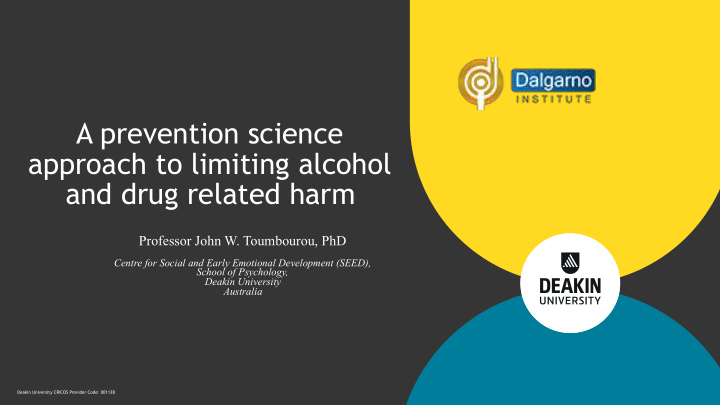



A prevention science approach to limiting alcohol and drug related harm Professor John W. Toumbourou, PhD Centre for Social and Early Emotional Development (SEED), School of Psychology, Deakin University Australia Deakin University CRICOS Provider Code: 00113B
During childhood and adolescence the body and brain have heightened sensitivity to neuro-adaptation in response to exposure to alcohol or drug use.
For example, youth that use alcohol prior to age 15 double their probability of developing alcohol dependence at age 21.
Australian experience – Scientific knowledge of adolescent vulnerability, has led coalitions in Australia to reject dominant adolescent harm minimisation theories and policies in favour of United States of America (USA) adolescent abstinence policies. – From the time the USA adopted adolescent abstinence policies such as age 21 alcohol laws (in the mid-1980s) rates of adolescent alcohol use began to fall sharply.
Australian experience – Our Australian research team completed surveys of adolescent alcohol and drug use in 2002 that were cross-nationally matched between Australia and the USA. – We established that Australia had twice the rates of adolescent alcohol and other drug use in 2002 compared to the USA (Toumbourou et al, 2009). – Australia at that time had some of the highest rates of youth alcohol and drug use in the world.
Australian experience – We established that harm minimisation policies operating in Australian schools at that time (Evans-Whipp et al, 2007) were associated with adolescent perceptions that community and family laws were favourable to adolescent alcohol and drug use (Hemphill et al, 2011). – Since that time our team have successfully advocated for a number of evidence-based adolescent abstinence policy changes that have successfully reduced adolescent alcohol and drug use in Australia.
Australian experience – In 2009, research from our group was extensively cited in revised Australian alcohol guidelines that recommended adolescents abstain from alcohol until age 18. – From 2004 to 2006 we designed a family-school partnership intervention that we evaluated as a school randomised trial. As part of the intervention parents received educational advice on setting rules to not allow or supply adolescent alcohol at home.
Australian experience – When followed 2-years from the start of the intervention adolescents in the schools that received the program had a 25% reduction in regular and heavy alcohol use. – A significant increase was noted in the intervention schools in more parents setting rules to not allow or supply adolescent alcohol use at home (Toumbourou et al, 2013).
Australian experience – Our team has worked with the Dalgarno Institute (https:// dalgarnoinstitute.org.au) and Communities That Care coalitions across Australia to implement evidence-based practices to encourage adolescent abstinence (Rowland et al, 2018). – In 2012 we initiated a national alcohol sales monitoring system that found only 40% of retailers complied with underage alcohol sales laws (Rowland et al, 2017). Our feedback letters to over 150 retailers resulted in underage alcohol sales monitoring systems being introduced by major alcohol retailers across Australia from 2013.
Evidence translation has assisted successful Australian efforts to reduce school-age alcohol and drug use problems
Australian reduction N = 41,000 Toumbourou et al, 2018: DOI: 10.1111/dar.12645
Messages for international cooperation – Evidence-based prevention practices can be used effectively by different countries around the world. – The Society for Prevention Research (www.preventionresearch.org http://euspr.org/) and organisations such as Communities That Care (www.ctc-network.eu www.communitiesthatcare.net www.communitiesthatcare.org.au) offer support and advice on effective programs and practices to prevent adolescent alcohol and drug use and related harms.
Messages for international cooperation – Australia’s experience shows that harm minimisation policies such as those recently introduced in Portugal need to be carefully evaluated (https://dalgarnoinstitute.org.au/images/ resources/pdf/researchreports/2018/DRR- PortugalPolicyAnalysis2018.pdf) for their potential to lead children and young people to perceive that social norms are favourable to alcohol and drug use.
Recommend
More recommend